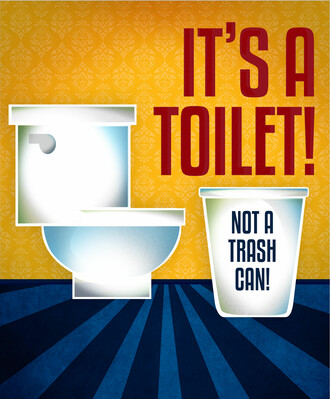
Would you believe me if I told you it’s been two years since we last posted about the 4 P’s? For an entire year, the 4 P’s consumed my life, as I spent countless hours researching and writing stories to convey the importance of properly disposing waste. It’s true!
Would you also believe me if I told you that my poetic storytelling ability wasn’t enough to convince people to dispose of waste properly? Sadly, this is also true…
But as long as this story needs to be told, I will tell it. And I think it’s time for a little recap.
Now, we know that there are only four things that can be safely flushed: Pee, Poo, Paper (Toilet) and Puke. But unfortunately, people continue to dispose of waste improperly, so today I would like to focus on the top three culprits.
Grease and Oil
First up, we have grease and oil. Some of the biggest contributors of grease and oil are frying and cooking oil, mayonnaise, salad dressing, butter and margarine and fats from meat. Many people think it is okay to dispose of grease and oils in their toilet or sink, because it often goes down like a liquid, but this is a dangerous misconception. Sure, it’s quick and easy to pour excess oil down the drain when you’re finished cooking but, in the long run, this is wreaking havoc on your pipes and sewer system.
As it makes its way to the wastewater (which contains chemicals and grease from other households) it bonds with calcium and turns into a soapy, waxy blob known as a fatberg (picture the iceberg in Titanic but replace ice with solid grease/fat). Over time, these fatbergs continue to grow and build up in your pipes causing clogs, blockages and very expensive repairs.
Proper Disposal
- Pour excess grease and oil into a container or jar (a great purpose for those glass jars), seal it and dispose of it.
- If you have grease or oil mixed with water (perhaps from boiling hot dogs), place a paper towel over your drain to filter the grease from the water as you pour it out. You can toss the grease-laden paper towel in the trash.
- Use a thickening agent to solidify the grease before throwing it in the garbage.
Flushable Wipes
Fatbergs are the result of grease and oil combined with the next culprit on our list, “flushable” wipes. What started as a convenient way to clean your baby’s tush has expanded over the last decade into a multi-billion-dollar industry. These days there are disposable wipes for just about everything! Baby wipes, makeup remover wipes, intimate wipes, disinfecting wipes, general cleaning wipes, pet wipes, grease wipes and moist towelettes. And what’s not to love? I’m certainly drawn to the ease and accessibility of them myself. But like we said before, the problem is not necessarily the wipe itself, but it’s improper disposal.
Just because it says “flushable” or “septic safe” doesn’t mean that it is. Regrettably, disposable wipes do not break down like toilet paper but, instead, act as nets that catch everything else that is flushed away.
Unfortunately, there is no regulation in Canada surrounding the use of the word “flushable” so consumers have been misled for a long time. According to the Municipal Enforcement Sewer Use Group (MESUG), Canadians spend $250M annually to clean up clogs caused by flushable wipes and, in 2016, the average cost to homeowners in Alberta to repair sewer backups was $21,852.15 per household!
Proper Disposal
- First of all, ensure you are using wipes made from cotton as these are less harmful on the environment (regular wipes take approximately 500 years to break down in a landfill).
- If you can, opt for compostable wipes that biodegrade and can be tossed in with your compost.
- If not compostable, ensure all other wipes are disposed of in the trash.
Hygiene Products
And the last repeat offender we’re going to discuss today are hygiene products. Hygiene products such as tampons, sanitary pads, diapers and cotton balls were designed to absorb 10 times their size in fluid. Like wipes, many hygiene products are labelled as “flushable”, but again, that’s not the case.
When flushed, they quickly expand and can easily clog the sewer system because these products don’t break down. Unlike toilet paper, the materials used to make these products don’t dissolve so they will just linger in the pipe while everything else that gets flushed builds up around it. The next thing you know, you have water flowing over the bowl and onto your bathroom floor.
Proper Disposal
- Wrap up hygiene products and toss them in the trash – it’s as simple as that!
In Closing
Every year, Canadians dish out approximately $250M to clean contaminated water supplies and remove everyday items, including grease and oil, disposable wipes and personal hygiene products, that are being flushed. This cost not only affects the company that is treating the water, but the customers as well.
Remember, there are only four things can be safely flushed down a toilet: Pee, Poo, Paper (Toilet) and Puke. Anything outside of this can have serious consequences:
- Contamination of our waterways
- Harm, disease and death of wildlife and aquatic life
- Damage to our water infrastructure
- Unnecessary excavation
- Thousands of dollars in damages and repairs